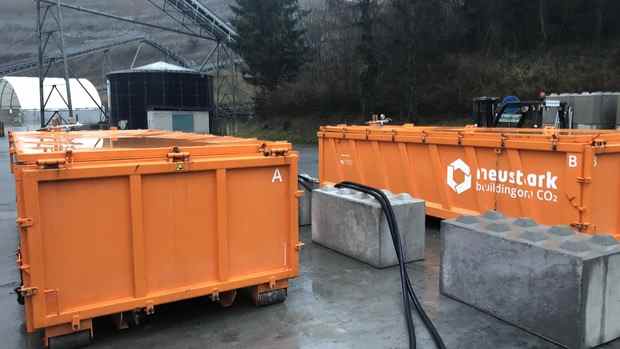The construction project in Zug is the largest project to date in which CO2-enriched concrete is used. The start-up Neustark helped develop the process.
Zurich Concrete is part of the cityscape in Zug. One office complex follows the next around the train station in the Swiss town, only the mailboxes of the companies that have rented premises in the concrete buildings are more numerous. However, the kitchen appliance manufacturer V-Zug is planning more than a functional building in the area: the company’s new assembly hall is the largest building in Europe to be made exclusively from recycled concrete.
The material is supplied by the Swiss building materials giant Holcim: The group works with the start-up Neustark, which has developed a process to bind CO2 in the production of recycled concrete. The construction should save 71 tons of CO2, as much as a small fir forest absorbs in a year.
It is no coincidence that the largest building made of recycled concrete in Switzerland to date is being built: the country is years ahead of its European neighbors when it comes to the use of recycled building materials. According to a study by the RWTH Aachen: “Switzerland is cited by experts as a leading example of the extensive use of recycled concrete in building construction.” Magali Anderson, board member and head of sustainability at the cement giant Holcim, confirms: “We recycle building rubble directly new building material. But so far we only do that in Switzerland.”
The company’s cement, which has a particularly high proportion of recycled material, has been sold exclusively in Switzerland for around three years. “In other countries, we are not yet allowed to sell it for regulatory and building law reasons, which we cannot understand,” says Holcim manager Anderson.
Top jobs of the day
Find the best jobs now and
be notified by email.
Cement is the most important component of concrete, but it has a high CO2 balance, which is due to the clinker: the basic material ensures that cement hardens when water is added. Clinker is mainly made from limestone, often consisting of limestone that is burned at a temperature of over 1400 degrees.
The best way to avoid greenhouse gases in cement production is to replace clinker with other materials such as construction waste or waste from other industries. It is already technically possible today to further significantly reduce the clinker factor. But building codes don’t always allow for that and are being adjusted very slowly, Anderson says.
Hoping for CO2 storage
The industry also has high hopes for the possibility of storing CO2 during the processing of concrete rubble. For this purpose, the Swiss construction chemicals group Sika commissioned an initial pilot plant on an industrial scale last October. Sika manager Carsten Rieger explains: “This enables us to achieve a complete circular economy with concrete.”
The concrete from demolished houses is first crushed, aggregates such as sand and stones are filtered out. These can be used again for mixing new concrete without any loss of quality, says Rieger.
What remains is cement stone, which is further broken up in the plant and mixed with CO2. During this process, the greenhouse gas is bound in the rock. “We make use of a chemical reaction that also occurs in nature,” says the Sika manager. However, by mechanically grinding the cement stone and adding other chemicals, the reaction is accelerated.
The end product is a powder that can replace part of the cement when mixing new concrete. Ten to 15 percent of cement could be saved in this way, says Rieger. 60 kilograms of CO2 per ton of crushed concrete could be bound in this way. It will probably take a while before the process with captured and stored CO2 is economical. But without such initiatives, the construction industry will find it difficult to become carbon neutral by 2050 as planned.
More: Why the building industry emits so much CO2 – and how to change that.
